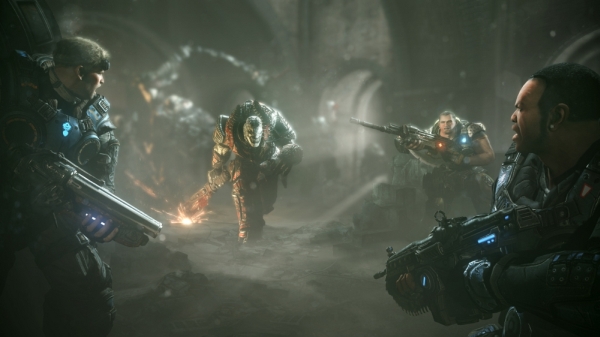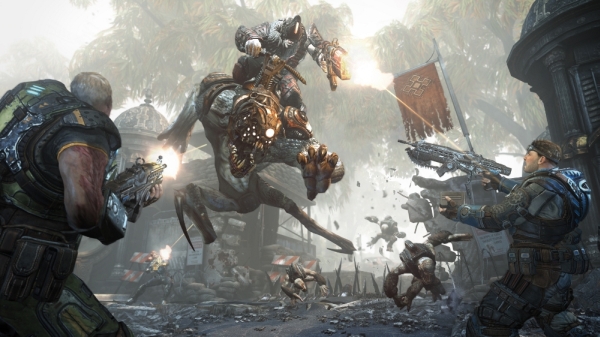
Gamers can be fickle and are often quick to judge a game by its cover, so let’s get this out of the way. Yes, Gears of War: Judgment is Microsoft and Epic’s way of squeezing in one more iteration of the phenomenally successful franchise before the next generation Xbox is released. Yes, it does have an “expansion pack” feel to it at times. But most importantly, yes, it’s damn fun – in fact, it’s probably the most fun of the series.
Platforms: Xbox 360
Publisher: Microsoft Studios
Developer: People Can Fly, Epic Games
Genre: First-Person Shooter… With Chainsaws… In the Past
Release Date: March 19, 2013
ESRB Rating: Mature
This is primarily thanks to developer People Can Fly, who took what players love about the Gears franchise, mixed in some fun tweaks and improvements, and tossed out the fluff. What remains is a lean, fat-free, chainsawing lovefest that constantly keeps you in the action and never lets up.
For example, the previous campaigns featured huge, sprawling maps that were beautiful to look at, but required a lot of boring wandering around until you triggered the next battle, which occurred in a relatively small space. You would then have to traverse some more pretty (but essentially empty) space to get to the next fight. Rinse and repeat. In contrast, Judgment features much smaller maps (completely cutting out the dull running around) where the fighting starts right away and is concentrated to that area. Finish off the attacking waves, move to the section right next door, and bam – you’re in the thick of it again. The campaign’s gameplay borrows heavily from the series’ signature Horde mode, which is a stroke of brilliance. Only a brief moment of quiet at the beginning of each level separates the intense, frantic firefights as waves of enemies try to turn you into COG mincemeat. Sure, many levels are fairly short and can be finished in only a few minutes (giving them a bite-sized “expansion pack” feel), but overall, the shift to a Horde-like structure injects some much-needed adrenaline into the campaign.
Other enhancements include moving a little bit faster, picking up small ammo clips automatically rather than having to press a button, and random enemy spawns – which means if you die, the enemy mix won’t be the same when you reload the checkpoint. This helps things get easier if you’re having a tough time, but on the flip side, it can also get worse. I like it a lot because it keeps things fresh and a little unpredictable.
A further refinement is the Declassified Mission option, which you can select at the beginning of each level. Declassified Missions add modifiers that increase the challenge, such as throwing in tougher enemies, restricting you to specific weapons, or reducing your vision with darkness or dust. It can also set a time limit to finish a level, which I’m not a huge fan of; fortunately, it’s not used often and it does ramp up the urgency and difficulty. Overall, the Declassified Mission modifiers add a fun, challenging twist to the bread and butter task of mowing down everything in sight – and if you don’t like it, you don’t have to turn it on.

However, selecting a Declassified Mission increases the rate at which you collect stars. Your performance on each level earns stars, which unlocks content like multiplayer characters and leaderboard points that you can brag to your friends about. At the completion of each level, a stat screen pops up so you can check on your performance. Unfortunately, this stat screen breaks the game flow and narrative, and once again gives an arcade-y expansion pack feel. It would have been better to give players the option of looking up their stats manually rather than force it upon them at the end of every single level.
This is a shame because the story is actually quite interesting. No, the series isn’t known for its particularly gripping stories (with the exception of the emotionally raw narrative of Gears of War 2), but fans will appreciate Judgment’s courtroom drama. Set 15 years prior to the original, and shortly after Emergence Day, new Lieutenant Damon Baird and his Kilo Squad (which includes a young private named Augustus “Cole Train” Cole) are put on trial for treason. You play as each character in Kilo Squad as they recount their actions during the Locust attack on Halvo Bay. While the story isn’t particularly deep and doesn’t explore the characters very well (the writers particularly wasted a huge opportunity to get into Cole’s personal feelings about his transition from sports star celebrity to weary rookie soldier), it does provide some interesting backstory to Baird and present-day events.
And as with many prequels, there are many continuity errors, like the new Rager enemy and several new weapons we’ve never seen before. However, you’ll quickly overlook these errors when you’re knee-deep in chunky piles of Locust meat as more enemies keep pouring on the pressure. The coolest level is a blatant nod (or rip-off, depending on how cynical you are) to the classic Call of Duty storming of Normandy Beach, complete with heavily fortified bunkers and mortar fire raining down on you. Yes, it’s pretty obvious what the developers were going for, but how can you not enjoy storming a beach against evil alien monsters?
Not surprisingly, the game looks great. No, there aren’t any huge graphical improvements over Gears of War 3, but the much more liberal use of vibrant color and bright sunlight really makes the world pop with life. In contrast, the unlockable Aftermath campaign looks and feels dull in comparison.
Aftermath is a “lost” Gears of War 3 level that reveals what Baird and Cole were doing when they left to find help. Since it is part of Gears 3, it naturally looks and plays exactly like Gears 3 – which unfortunately reveals the weaknesses that Judgment eliminated. The muted, drab colors, the long treks where nothing happens, even the squad AI where they follow you like magnetic bees and often get in your way – it all highlights how Judgment is so much better.
Better still is multiplayer, with the inclusion of two new game modes. Fans will be shocked and disappointed that the traditional co-operative Horde mode is gone – however, the replacement Survival mode is an absolute blast. It’s basically the same as Horde, except you have three objectives to defend against 10 increasingly difficult waves of enemies. If an objective is destroyed, you move back to defend the next; if all three are destroyed, you lose.

But the biggest and best change is the addition of player classes. You can choose from an Engineer, who can repair fortifications and deploy sentries; the Soldier, who can replenish ammo; the Medic, who can heal and revive players; and the Scout, who can climb up into otherwise inaccessible areas and toss spot grenades that not only highlight enemies, but debuff them so they take extra damage. This adds a huge strategic twist to the mix, since you need a good blend of classes to succeed. For example, Soldiers are the only source of ammo, and Medics are the only ones who can revive downed players. Each class also has its own specific weapon set, so choosing your class actually requires some thought. It also requires a lot of your time, because you’ll be glued to your controller for hours gleefully blowing Locusts to smithereens again and again.
Overrun is a competitive multiplayer version of Survival, with one team as the COG (using the same classes) and the other as the Locust (with a similar class system as Beast Mode in Gears 3), and yes, it’s as awesome as it sounds. Things can get pretty intense as the clock ticks down and you’re only moments away from a hard-fought victory or a crushing last-second defeat. Where’s the Soldier with ammo? Is someone playing a Kantus and can heal you? Overrun is clearly the multiplayer gem of the package, and had better darn well be included in future releases.
The other multiplayer modes have been condensed down into the traditional Team Deathmatch, the new Free For All (a long-desired every-man-for-himself mode), and Domination (i.e. King of the Hill). These all play like your typical Gears multiplayer, but with an added bit of speed and multi-level maps. Not only can you get up high and snipe, but you can also jump down onto people’s heads and knock them to the ground. Fun!
And that word pretty much sums up Judgment. No, the story isn’t deep, the campaign is short, and there aren’t any mind boggling graphical upgrades. But that’s not the point – if you love Gears, you will thoroughly enjoy Judgment. From the intense Horde-like campaign to the frantic Survival and Overrun modes, you will have the most fun ever playing a Gears game. So rev up that chainsaw: it’s go time, baby!

Review Disclosure: A retail copy of Gears of War: Judgment was purchased by Warp Zoned for the purposes of this review.







